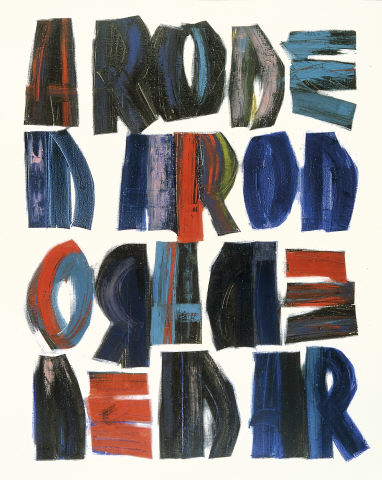
- Canvas
- Oil
- Inv. 80P536
João Vieira
Uma Rosa É
João Vieira’s calligraphic painting developed as a series of abstract experiments that proposed the use of letters as a pattern through the compositional exploration of basic geometric figures. His experiments with letters, which involved using them as the subjects of pictorial exercises, would subsequently motivate the artist to use other methods, such as performance. They arose in the wake of the contact that he established with what was known as the Group Café Gelo, located below his studio. This group, which included José Escada, René Bertholo, Hélder Macedo and Herberto Hélder, among others, would bring him closer to poetry and surrealist experimentation. This pictorial gestualism would be further explored after 1957, in Paris, as a result of his association with António Saura of the El Paso Group.
The theme of Uma Rosa É is a verse taken from the poem “Sacred Emily” by Gertrude Stein, “A rose is a rose is a rose is a rose”, which puts forward the tautological idea that things are what they are. The connection between the painting and the poem is established less through the title than through the figuration of the letters, which, by not losing their linguistic properties, allow themselves to be read. In other words, although the conceptual dimension of the letter-sign is made problematic by its being transformed into pictorial material, there is meaning in the combination of the letters, stemming from their observance of the conventions of language, which is disturbed only by the orientation of the writing in the composition:
A ROsE
Is AROS
ORAsIE
sEIsAR
João Vieira weighs up the semantic load of the letters, intentionally generating an ambiguous diversion. In so doing, he brought himself into proximity with the concerns of concrete poetry, with which he came into contact in the 1960s, by proposing that letters should not lose their identifying character as writing, and that they should simultaneously be converted into images.
The pictorial plane of this large canvas is arranged into four horizontal bands, where, in spite of the symmetry generated, which is confirmed by the definition of the picture and the regular layout of the letters, the somewhat misaligned form that it possesses confers dynamism on the composition, established by the use of various shades on each of the elements. The painting therefore reveals a harmony that is achieved between the balance of the general layout of the motif and the individual robustness of each character. For this reason, there is a compositional dimension which is based on the gestural theme: the letters as base structure are related to a larger composition, ordered by the superstructure of the picture. In addition to highlighting and orienting the overall form, the white background reinforces the explorations of a gesture by which the artist makes the perception of the act of painting depend on the handling of the textures of the material and the contrasts between varied ranges of colour such as reds, greens, pink and several shades of blue, the dominant colour. The visual result accentuates the act of painting as an expressive medium, making writing the subject matter of the painting.
Maria Coutinho
May 2010
| Type | Value | Unit | Section |
| Height | 200 | cm | |
| Width | 161 | cm |
| Type | signature |
| Type | date |
| Type | Acquisition |
| Densidade Relativa |
| Lisboa, CAM/FCG, 2005 |
| ISBN:972-635-169-x |
| Monografia |
| Densidade Relativa |
| Leonor Nazaré |
| Curator: Leonor Nazaré |
| 27 de Outubro de 2005 a 22 de Janeiro de 2006 HALL de entrada e Piso 1 no CAMJAP |
| 12-8-2006 a 26-11-2006 Centro Cultural Emmerico Nunes e Centro das Artes de Sines |
| A ideia de trabalhar o conceito de densidade das obras começou por surgir com a constatação de que a palavra é muito frequente nos textos de crítica de arte. O mesmo acontece com a palavra intensidade que facilmente se associa à primeira. Rapidamente se percebe que densidade pode ser sinónimo de riqueza ou de impenetrabilidade, quando não se refere mais literalmente à acumulação de elementos no espaço, por oposição ao vazio ou à rarefacção. O pensamento em torno destas variantes conduziu à percepção de que o conceito poderia ser útil no estabelecimento de um contínuo entre a matéria do pensamento e a dos corpos e objectos, neste caso, a das obras de arte. |
| KWY - Paris 1958-1968 |
| Centro Cultural de Belém |
| Curator: Margarida Acciaiuoli |
| 15 de Março de 2001 a 22 de Julho de 2001 Grande Hall de Exposições do Centro Cultural de Belém |
| Exposição sobre o grupo KWY: René Bertholo, Lourdes Castro, Christo, Gonçalo Duarte, José Escada, Costa Pinheiro, João Vieira e Jan Voss. A inauguração da exposição foi no dia 15 de Março de 2001, fazendo parte desta um almoço no Restaurante A Commenda, pelas 13 horas. |
| Antológica de João Vieira |
| Museu de Serralves |
| Curator: Museu de Serralves |
| Janeiro de 2002 a Março de 2002 Museu de Serralves, Porto |
| Exposição antológica da produção de João Vieira. |